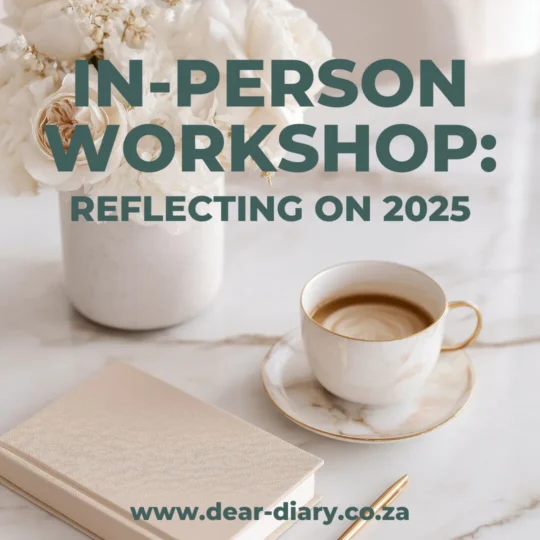You can change your life by combining SMART goal-setting with visualisation techniques that rewire your brain for success. Start with specific, measurable objectives aligned with your values, then create vision boards that utilise neuroplasticity to double your confidence in achieving goals. Daily affirmations and emotional journalling enhance resilience whilst tracking progress through structured routines. Research shows this integrated approach reduces anxiety by 8% and improves emotional regulation considerably. The complete structure reveals exactly how to sustain momentum through challenging seasons.
Understanding Your Personal Growth Journey as a Modern South African Woman
Whilst society celebrates women’s educational achievements, the harsh reality reveals a troubling paradox for modern South African women.
You’re more qualified than ever, yet unemployment rates consistently exceed men’s across every education level.
Even with a degree, you face higher unemployment rates than your male counterparts.
The statistics illustrate a frustrating depiction—your qualifications don’t guarantee economic security.
Your hard-earned credentials become meaningless papers when the job market consistently favours others over your documented expertise and achievements.
However, this challenge creates opportunity for personal growth.
Understanding that nearly half of women prioritise stable income for financial independence means you’re not alone in seeking clarity.
Research from 3,742 skilled women reveals that financial security remains the primary motivator driving career decisions across all industries.
Creating goal-tracking systems helps transform career aspirations into measurable progress during uncertain times.
Navigating these complexities requires intentional planning and self-acceptance to transform uncertainty into purposeful action.
Your journey requires navigating both systemic barriers and personal aspirations simultaneously.
Setting SMART Goals Using Dear Diary’s Planning Framework
How do you change overwhelming aspirations into achievable milestones that actually move your life forward? You alter them using SMART goals within Dear Diary’s structured framework.
Specific: Define exactly what you’ll accomplish. Instead of “get healthier,” write “exercise 30 minutes daily, five days weekly.”
Measurable: Track progress with numbers. Setting clear financial targets for monthly savings creates better accountability than vague monetary goals. Understanding how much progress you’re making allows you to identify areas needing adjustments and celebrate achievements when you reach your targets.
Attainable: Balance ambition with reality. Losing 8kg in three months? Realistic. Losing 20kg? You’re setting yourself up for disappointment. Using dedicated planners and notebooks helps you break down ambitious goals into smaller, manageable daily actions.
Relevant: Align goals with your values and long-term vision. The undated format allows you to start working towards your most meaningful objectives at any time without waiting for a new calendar year.
Time-bound: Set deadlines. “Learn Python programming within six months” creates urgency and accountability that drives consistent progress.
Creating Your Vision Board for Life Transformation

Your brain doesn’t distinguish between vividly imagined experiences and real ones—that’s why vision boards work so powerfully for goal achievement.
You’ll uncover how visual goal mapping techniques convert abstract dreams into concrete action plans, whilst digital vision board tools offer flexibility that traditional poster boards simply can’t match.
These methods aren’t just feel-good exercises; they’re neuroplasticity hacks that literally rewire your brain for success. Research reveals that vision board users demonstrate nearly twice the confidence levels in achieving their goals compared to those who don’t utilise visual planning methods.
When you combine visual goal-setting with structured planning tools, community support can increase your goal achievement success rate by an impressive 76%.
The most effective planners blend structure and inspiration to create a holistic experience that accommodates both your biggest dreams and daily tasks, making the planning process both beautiful and effortless.
Visual Goal Mapping Techniques
Something extraordinary happens when you change abstract dreams into concrete visual representations—your brain begins treating those images as roadmaps rather than fantasies. This neurological shift activates whole-brain processing, creating vivid mental rehearsals that mirror real-life experiences.
Your visual mapping technique should break complex goals into manageable, sequential steps. Use symbolic colours and imagery that trigger emotional responses—these elements activate reward centres and generate positive associations with your objectives. Tools like mind maps create clear connections between your primary aspirations and supporting objectives.
The statistics reveal compelling evidence: visual goal mapping links to significantly higher achievement rates. This happens because it utilises neuroplasticity, forming new neural pathways through consistent visualisation. Strategic planning becomes even more powerful when combined with dedicated tools that encourage consistent self-reflection and monthly progress reviews. Modern digital planners offer customisable layouts and eco-friendly planning solutions that seamlessly integrate visual goal mapping with daily organisation.
The technique reduces perceived effort gaps between current reality and desired outcomes, making success feel more attainable for South African professionals across all industries.
Digital Vision Board Tools
While traditional poster board and magazine cutouts served their purpose, digital vision board tools have revolutionised how South Africans convert aspirations into reality.
You’ll access your goals across all devices, making daily reinforcement effortless. Real-time updates mean you can adjust objectives instantly—no more outdated images mocking your progress.
Digital tools offer eco-friendly alternatives whilst enhancing self-efficacy. Research shows users exhibit twice the confidence of non-users.
You’ll customise fonts, colours, and layouts for personal branding, then share with mentors for accountability. These platforms activate neural pathways that strengthen goal-oriented behaviours through consistent visual exposure. The most effective approach involves breaking big goals into manageable steps that you can track and visualise through these digital platforms. Most importantly, these platforms provide anxiety reduction through visual anchors during stress, keeping your long-term vision visible despite daily distractions.
Combining digital vision boards with physical journals helps create a comprehensive planning system that bridges digital convenience with tactile reflection.
Harnessing the Power of Daily Affirmations and Mindset Shifts
When neuroscientists peer inside the brain during moments of self-affirmation, they find something extraordinary: your ventral striatum lights up like a reward centre getting its favourite treat, whilst your stress-processing regions quiet down like they’re finally getting a break.
Here’s what makes affirmations actually work: future-focussed statements beat past reflections every time. “I will exercise tomorrow” trumps “I exercised yesterday.”
Your brain’s neuroplasticity reshapes itself through repetition, building stronger self-processing networks. This process works particularly well in the South African context, where resilience and forward-thinking mindsets are deeply valued cultural traits.
But there’s a catch—if you’ve got low self-esteem, generic affirmations might backfire. Instead, align statements with your core values and Ubuntu principles. The key is making them personal and specific to your individual goals, interests, and aspirations rather than using one-size-fits-all approaches.
Studies show this reduces sedentary behaviour by 25% and bridges that pesky intention-action gap.
Building Resilience Through Emotional Journalling Techniques

You’ve probably noticed that bottling up emotions doesn’t make them disappear—it just creates a mental pressure cooker that eventually explodes.
Emotional journaling changes this chaotic internal storm into structured, manageable perceptions that actually build your resilience over time. Research demonstrates that writing about difficult experiences can boost your immune function by increasing lymphocyte activity, giving you both mental and physical strength to handle future challenges.
Structured Reflection Writing Methods
Building emotional resilience isn’t about suppressing difficult feelings—it’s about developing systematic approaches to comprehend and work through them effectively.
Structured reflection writing transforms chaotic emotions into actionable understanding through proven frameworks.
Start with step-by-step observation logging. Document specific triggers, your emotional responses, and outcomes. This creates patterns you can actually work with, rather than vague feelings drifting through your mind.
Use the “What? So What? Now What?” template for deeper analysis. What happened exactly? So what does this situation mean for your wellbeing and relationships?
Now what’ll you do differently next time? Track your coping strategies’ effectiveness across different scenarios—some techniques work better in specific situations than others. Regular reflection sessions allow you to adjust your strategies based on what you observe working and what isn’t delivering the emotional stability you need.
Processing Difficult Emotions Daily
Processing Difficult Emotions Daily
Although difficult emotions feel overwhelming in the moment, daily processing through targeted journalling techniques creates measurable resilience that compounds over time. You’ll reduce stress levels and clear pre-sleep rumination whilst building emotional awareness.
Research shows structured prompts guide deeper reflection. This helps you reinterpret challenging experiences constructively. Writing facilitates cognitive integration and understanding of traumatic events, making narrative coherence essential for emotional processing benefits.
Essential Daily Processing Strategies:
- Write for 15-20 minutes using specific prompts that investigate emotional triggers and flexible responses.
- Practice gratitude-focused entries to improve sleep quality and reduce cognitive dissonance. These techniques are particularly valuable for managing the unique stresses of South African daily life.
- Use reappraisal techniques to reframe difficult experiences and strengthen self-control. This approach helps build the mental fortitude needed to navigate challenging circumstances with greater clarity.
- Maintain consistency beyond 30 days for maximum mental health benefits and lasting emotional regulation.
Tracking Growth Through Writing
Tracking Growth Through Writing
Consistent emotional journaling creates a documented record of your psychological patterns, but tracking specific growth markers changes scattered entries into measurable progress indicators. Research shows 5% average reduction in mental health symptoms with systematic monitoring.
| Growth Area | Weekly Metric | Success Indicator |
|---|---|---|
| Stress Management | Intensity (1-10) | 65% report improvement |
| Anxiety Symptoms | Frequency count | 9% reduction observed |
| Sleep Quality | Hours/satisfaction | Improved through gratitude |
| Emotional Regulation | Response time | Decreased rumination |
You’ll notice patterns emerging after 30 days of consistent tracking. Document specific triggers, coping strategies, and recovery times. Writing down thoughts reduces worry and rumination patterns, creating clearer mental space for recovery.
This approach transforms subjective feelings into objective data that you can analyse. South African wellness practitioners increasingly recommend this structured method for understanding personal mental health trends.
Establishing Morning and Evening Routines That Stick

When 97% of people claim they’ve a morning routine but over half skip breakfast and stumble through their days feeling scattered, something’s clearly not working.
The difference between highly productive individuals and everyone else isn’t complicated—92% prioritise planned routines that actually stick.
Here’s what works for South Africans:
1. Hydrate before you caffeinate****
Your body needs water first, coffee or rooibos second. Start with a full glass of water to kickstart your metabolism.
2. Get natural light exposure****
Step outside for a few minutes to soak up that beautiful South African sunshine. It regulates your circadian rhythm naturally and boosts your mood.
3. Include light movement****
Even basic stretches enhance circulation and energy. Try a few sun salutations or a quick walk around your garden before the day heats up. Your body will thank you for it.
4. Plan your evening routine too
Tomorrow’s success starts with tonight’s preparation. Set out your clothes, prepare your lunch, and wind down properly. This simple habit transforms chaotic mornings into smooth starts. Consistent morning habits contribute to better memory and emotional well-being, allowing you to develop resilience for whatever the day brings.
Tracking Progress With Dear Diary’s Achievement Monitoring Tools
The gap between setting goals and actually achieving them isn’t motivation—it’s measurement. Dear Diary’s achievement monitoring tools reshape vague aspirations into trackable progress.
You’ll capture daily wins through structured entries, whether fixing code bugs or excelling in new skills. The platform’s snapshot management lets you document specific moments of growth.
Integrated comments provide background for future reflection. Use the “done list” approach—focus on completed tasks rather than endless to-dos. This builds momentum and reinforces progress.
Link emotional states to achievements through emotion-experience mapping. Small, consistent documentation creates powerful visual proof of your forward movement over time.
Track your emotional wellbeing alongside achievements to identify patterns between mental state and productivity levels. This dual awareness helps optimise both performance and personal satisfaction in your growth journey.
Overcoming Self-Doubt and Building Unshakeable Confidence

Overcoming Self-Doubt and Building Unshakeable Confidence****
Progress tracking reveals patterns, but those patterns often expose an uncomfortable truth: your biggest obstacle isn’t external circumstances—it’s the voice in your head questioning every move you make.
Self-doubt doesn’t just whisper criticism; it rewires your entire decision-making process. Research shows sequential doubt activation actually decreases uncertainty through meta-cognitive processes. This means you can train your brain differently. When individuals experience chronic uncertainty followed by additional doubt triggers, they naturally begin to doubt their doubt rather than compound their insecurity.
Self-doubt rewires your decision-making, but research proves you can retrain your brain through deliberate meta-cognitive practices.
Four Evidence-Based Confidence Builders:
- Practise embodied cognition – Simple head nodding whilst reviewing goals literally influences doubt fluctuations. Your body language directly impacts your mental state.
- Develop self-compassion practices – Counter self-criticism with intentional kindness towards yourself. Many South Africans struggle with the cultural pressure to appear strong at all times, but self-compassion builds genuine resilience.
- Engage in team activities – Sports participation measurably improves self-esteem and reduces uncertainty. Whether it’s rugby, football, or netball, team environments naturally build confidence through shared achievement.
- Implement cognitive restructuring – Reframe doubts into actionable behavioural perspectives rather than character defects. Instead of “I’m not good enough,” ask “What specific skills can I develop?” This shift transforms paralysis into progress.
Navigating Life Transitions With Grace and Purpose
Life doesn’t pause to ask if you’re ready for its next curveball, yet research reveals that 87.1% of people successfully steer through leaving formal education—proving you’re more equipped for changes than your anxiety suggests.
Major shifts like parenthood (experienced by 43.2% of participants) or career changes reshape your social networks and psychological well-being.
Multiple alterations actually reduce emotional symptoms—averaging 4.62 events in young adulthood shows resilience-building effects.
Your approach matters: those with greater resources and support manage changes more successfully, whilst others face additional challenges. This period is particularly crucial since early adulthood marks the fastest weight gain phase of life when dietary habits significantly impact long-term health outcomes.
Focus on strengthening support systems during shifts.
Sequential changes like education-to-employment-to-parenthood create varied pathways, not predetermined outcomes.
Cultivating Gratitude Practices for Mental Wellness
You’ve probably heard about gratitude practices, but here’s what the research actually shows: spending just 15 minutes daily on structured gratitude exercises can reduce anxiety symptoms by nearly 8% whilst enhancing life satisfaction scores by almost 7%.
Whether you’re scribbling three good things in a notebook, practising mindful appreciation during your morning coffee, or writing thank-you notes to people who’ve impacted your life, these aren’t just feel-good activities—they’re rewiring your brain to prioritise positive stimuli over negative rumination.
The stress reduction benefits alone make gratitude worth your time, especially when you’re dealing with life changes that tend to amplify worry and self-doubt.
Daily Gratitude Journaling Methods
Three simple words—”I am grateful”—can fundamentally rewire your brain’s default patterns and change how you experience daily life.
Concrete writing beats mental noting every time, shifting your focus from what’s wrong to what’s working. This practice creates lasting neural pathways that enhance overall well-being.
Here’s how to make gratitude journaling stick:
- Write it down daily – Mental notes won’t cut it; physical documentation deepens emotional impact by 25% in sleep quality improvements alone. The act of writing engages multiple brain regions simultaneously.
- Use specific language – “I’m grateful for rooibos tea” becomes “I’m grateful for my evening rooibos ritual that helps me unwind after long Johannesburg traffic.” Detail amplifies the emotional resonance.
- Maintain consistency – Pick morning or evening; timing matters less than daily practice. Whether you journal before sunrise or after the braai, stick to your chosen time.
- Follow structured prompts – Target different gratitude dimensions for thorough mental wellness benefits.
Mindful Appreciation Techniques
When your mind defaults to scanning for problems—taxi delays, load shedding schedules, that neighbour’s barking dog—mindful appreciation techniques act like a mental reset button, training your brain to notice what’s actually going well.
These practices physically reshape your neural pathways. Consistent gratitude exercises increase cortical thickness in attention regions whilst reducing amygdala stress responses. You’re literally rewiring automatic negativity patterns.
| Technique | Brain Benefit |
|---|---|
| Gratitude letters | Triggers dopamine release |
| Sensory appreciation | Improves emotional resilience |
| Group gratitude exercises | Strengthens social connections |
Start with three daily observations—textures, sounds, moments of ubuntu from your community. Notice the warmth of rooibos tea, the sound of hadedas calling, or a colleague’s helpful gesture. Your language will shift from “I’m struggling” to “we’re managing together.”
Gratitude’s Stress Reduction Benefits
Research consistently shows that gratitude isn’t just feel-good psychology—it’s a scientifically-backed stress buster that creates measurable changes in your body’s stress response systems.
When you practise gratitude regularly, you’re literally rewiring your brain to handle stress better whilst improving your physical health.
Here’s what happens when you embrace gratitude:
- Cortisol drops considerably – Your stress hormones decrease, creating a calmer internal environment.
- Heart function improves – Blood pressure lowers and cardiac regulation strengthens measurably. This is particularly beneficial for South Africans dealing with high-stress urban environments.
- Sleep quality increases – Pre-bedtime reflection reduces stress and promotes restorative rest. Better sleep means improved productivity and mental clarity throughout your day.
- Emotional resilience builds – You’ll recover faster from setbacks and negative experiences. This enhanced emotional strength helps you navigate daily challenges with greater ease and confidence.
Finding Your Community and Support Network
How do you build the kind of support network that actually sticks around when life gets messy? Focus on three key areas.
First, seek structured community programmes—permanent supportive housing shows 94% retention rates when proper systems exist.
Second, connect with peers who’ve walked similar paths. They’ll reduce your isolation whilst improving your self-care skills through shared experience.
Third, prioritise quality over quantity in relationships. Strong social ties directly correlate with lower depression, reduced mortality risks, and better treatment adherence.
Remember: even non-perfect supporters can lower relapse rates considerably.
Integrating Faith and Spirituality Into Personal Development
Although spirituality might seem separate from practical personal development, integrating faith into your growth journey creates one of the most powerful transformation catalysts available.
Research shows 51% of people experience significant life change through faith practices, with Bible reading and worship attendance doubling your chances of meaningful transformation.
Faith practices create measurable transformation, with scripture and worship doubling your potential for meaningful personal change.
Your spiritual integration strategy should include:
- Daily scriptural engagement – Regular reading strengthens growth outcomes across all communities. This practice forms the foundation of spiritual development.
- Active worship participation – Church attendance consistently predicts higher change rates. Connecting with your faith community provides essential support and accountability.
- Servant-focussed actions – Selfless service aligns with life-altering spiritual maturity. Ubuntu principles of interconnectedness enhance personal growth through serving others.
- Faith-based identity adoption – Viewing yourself as spiritually committed increases change likelihood threefold. This identity shift becomes the cornerstone of lasting personal transformation.
Creative Expression as a Pathway to Self-Discovery
Your creative voice isn’t hiding—it’s waiting for you to stop overthinking and start expressing what’s already inside you.
When you create art, write, or investigate any form of expression, you’re fundamentally holding up a mirror that reflects parts of your identity you might not have recognised before.
This process of authentic creative expression doesn’t just produce beautiful work; it builds genuine confidence rooted in who you truly are rather than who you think you should be.
Unlocking Inner Creative Voice
Discovering Your Inner Creative Voice****
When you think about creativity, you probably picture artists hunched over canvases or writers scribbling in coffee shops. But your inner creative voice isn’t about producing masterpieces—it’s about authentic self-expression that drives personal growth.
Research shows everyday creativity differs from artistic pursuit, linking directly to life satisfaction rather than mental health challenges. Your personality traits, whether you’re extraverted or neurotic, can actually fuel creative expression in digital spaces.
Here’s how to unlock your creative voice:
- Align your self-perception with expression for increased life satisfaction.
- Track skill development through measurable creative milestones. Document your progress consistently.
- Embrace authentic social media sharing to enhance positive mood. Let your genuine voice shine through your posts. This builds meaningful connections with your community.
- Implement creative problem-solving to build confidence across different areas of life.
Art as Identity Mirror
Standing before a piece of art that stops you in your tracks, you’re experiencing more than aesthetic appreciation—you’re looking into a mirror that reflects your deepest sense of self.
Art reveals who you are through what connects with you. That multicultural story triggering childhood memories? It’s shaping your values whilst reflecting South Africa’s rich tapestry of cultures and histories.
The museum selfie you’re posting? You’re curating your identity for the world to see, sharing your connection to local galleries or street art in Cape Town, Johannesburg, or Durban.
When you engage with creative works—whether traditional Ndebele patterns, contemporary pieces at the Zeitz Museum, or vibrant township murals—you’re processing emotions and clarifying beliefs.
Each artistic encounter becomes part of your personal narrative. This helps you understand your place in the world whilst building confidence in your unique viewpoint.
In a country where art has long been a vehicle for social commentary and cultural expression, your artistic preferences reveal layers of your identity you might not have recognised before.
Expression Builds Authentic Confidence
Expression Builds Authentic Confidence****
Vulnerability becomes your greatest strength when you pick up that paintbrush, sit down at the piano, or start writing in your journal. Creative expression transforms internal chaos into clarity, building authentic confidence that external validation can’t touch.
You’re not performing for applause—you’re developing resilience through repetitive creation processes that strengthen decision-making abilities. This process creates lasting change from within.
- Reduce stress naturally – 57% of LGBTQ+ participants experienced measurable anxiety relief through artistic mediums.
- Build sustained self-esteem – Structured creative workshops showed confidence improvements lasting 12 months. These results demonstrate the lasting power of consistent creative practice.
- Develop problem-solving flexibility – Generating diverse ideas strengthens critical thinking skills. Creative challenges mirror real-life situations, building mental adaptability.
- Create authentic connections – Group environments combat isolation whilst nurturing genuine community belonging.
Balancing Career Ambitions With Personal Fulfilment
Although society loves to paint career success and personal happiness as opposing forces, the reality is far more complex—and frankly, more achievable than you’ve been led to believe.
The secret isn’t choosing between ambition and fulfilment—it’s understanding they’re interconnected. When 83% prioritise meaningful work over prestige, you’re witnessing a fundamental shift in how South Africans approach their careers. Success means aligning your strengths with purpose-driven roles that contribute to both personal growth and societal transformation.
| Career Focus | Personal Impact | Integration Strategy |
|---|---|---|
| Strength-based work | +578% job satisfaction | Use top talents daily |
| Meaningful tasks | 66% lower burnout | Purpose over prestige |
| Value alignment | 3-year longer retention | Match personal ambitions |
| Flexible boundaries | 52% prefer integration | Fluid work-life interplay |
| Skill development | Higher engagement | Continuous learning focus |
Smart professionals utilise their innate abilities rather than fixating on weaknesses. This approach proves particularly valuable in South Africa’s diverse economy, where authentic leadership and cross-cultural competence create lasting impact.
The modern workplace demands professionals who can navigate complexity whilst maintaining personal values. Integration becomes the pathway to sustained excellence.
Healing Past Wounds Through Therapeutic Writing
You’ve likely carried emotional baggage for years, wondering if those old wounds will ever truly heal.
Therapeutic writing offers a scientifically-proven path forward through structured interventions that help you process trauma systematically rather than letting it fester in silence.
Structured Writing Interventions
When trauma and unresolved emotions create mental fog that seems impossible to clear, structured writing interventions offer a research-backed path towards healing that transforms abstract pain into concrete comprehension.
Unlike random journalling, these interventions follow specific structures that guide you through emotional processing without overwhelming your system. Research shows sustained improvements lasting up to four months. Measurable reductions in stress, anxiety, and depression have been documented across diverse populations.
Four Essential Components of Effective Structured Writing:
- Emotional clarity exercises that transform internal chaos into tangible language
- Time-limited sessions preventing cognitive rumination and over-analysis
- Progressive structures building from basic emotions to complex trauma processing. These frameworks adapt to individual healing paces whilst maintaining therapeutic momentum.
- Integration periods allowing processed emotions to settle before continuing. This prevents emotional overwhelm and supports sustainable healing progress.
Processing Emotional Trauma
Processing emotional trauma through writing isn’t about reliving painful memories—it’s about changing raw hurt into organised understanding that your mind can actually work with.
Six-week writing interventions enhance resilience scores from 64.3 to 74.2—that’s meaningful progress you can measure.
Whilst meta-analyses show mixed results for PTSD specifically, participants consistently report fewer sick days and healthcare visits afterwards.
Here’s what works: combine writing with therapist guidance, maintain consistent sessions, and expect initial discomfort.
Your mind needs structure to process chaos. Writing creates that structure, converting overwhelming emotions into manageable narratives you can actually heal from.
Building Self-Awareness Skills
Building Self-Awareness Skills
Self-awareness isn’t some mystical concept—it’s a learnable skill that develops when you consistently translate your inner chaos into written words. When you externalise overwhelming emotions onto paper, they change from subjective storms into observable patterns you can actually analyse.
Here’s how writing builds genuine self-awareness:
Emotional Distance Creation – Writing separates you from intense feelings, allowing objective examination of what’s really happening. This distance helps you process difficult emotions without being overwhelmed by them.
Pattern Recognition – Regular journalling reveals triggers and behavioural cycles you’d never notice otherwise.
Cognitive Shift – Documentation moves your brain from reactive mode into analytical processing. Instead of simply experiencing emotions, you begin to understand them. This shift transforms how you respond to challenging situations.
Identity Integration – Reviewing past entries connects your historical self with who you’re becoming today. It’s particularly valuable during major life transitions or periods of uncertainty.
Developing Financial Confidence and Goal Achievement
Although building financial confidence might feel overwhelming when you’re staring at complicated investment statements or retirement planning calculators, the reality is that most people struggle with the same basic challenges you’re facing right now.
Only a quarter of South African adults consider themselves extremely confident with money decisions. Meanwhile, the vast majority regularly encounter confusing financial terms that leave them feeling uncertain about their choices.
Start with what you know. Focus on areas like saving for specific goals, where many people feel more comfortable and confident.
Master budgeting basics before tackling complex investments. Building a solid foundation with everyday money management creates the confidence needed for more advanced financial decisions.
Don’t let the fact that few people can answer basic financial questions discourage you. Use it as motivation to join that knowledgeable minority and take control of your financial future.
Maintaining Motivation During Challenging Seasons
When your initial excitement fades and the daily grind starts wearing you down, you’re entering what researchers call the “messy middle” – that brutal phase where 73% of people abandon their goals.
This challenging season tests your commitment like nothing else. Your motivation shifts from intrinsic enjoyment to identified regulation – valuing activities that align with your bigger vision. It’s a natural part of the journey that every South African entrepreneur and goal-setter experiences.
Reconnect with your “why” through regular reflection on your personal mission. Whether you’re building a business in Cape Town or pursuing studies at Wits, your underlying purpose remains your anchor.
Use SMART goal-setting**** to track short and long-term objectives. This proven framework helps you navigate everything from career advancement to community development projects.
Prioritise process over outcomes to reduce anxiety during decisive moments. Focus on consistent daily actions rather than fixating on distant results.
Practise cognitive reframing** by viewing challenges as growth opportunities. Transform setbacks into stepping stones, embracing the resilient spirit** that defines our nation’s character.
Creating Accountability Systems That Actually Work
By the time most people realise they need accountability, they’ve already failed at least three major goals this year – and that’s completely normal.
The problem isn’t willpower; it’s building systems that actually stick. Start with self-tracking tools like journals or smartphone apps that show tangible progress.
Systems beat willpower every time – track your progress with tools that show real results, not just good intentions.
When you can see your patterns, you’ll stop making excuses and start solving problems.
Next, create coordinated support teams – personal trainers, life coaches, or wellness practitioners – with clear, non-overlapping roles.
Regular communication prevents conflicting advice. This approach works particularly well in South Africa’s community-focused culture, where collective support drives individual success.
Most importantly, build flexible systems that modify when life happens. Rigid structures crumble at the first obstacle, whether it’s load shedding disrupting your routine or unexpected work commitments.
Celebrating Milestones and Recognising Growth Wins
Your accountability systems won’t sustain themselves without a recognition strategy that actually rewards progress.
Without celebrating wins, you’re fundamentally running a marathon without water stations—exhausting and unsustainable.
Research shows engagement increases 14% when progress gets validated. Resilience strengthens by 42% through consistent acknowledgement.
Here’s how to build effective milestone recognition:
- Track micro-achievements daily using local apps like JournalOwl or traditional journals to prevent missed successes. This creates a consistent record of your growth journey.
- Implement peer recognition systems for 35.7% greater impact than self-validation alone. Ubuntu philosophy emphasises community support, making peer acknowledgement particularly powerful in South African contexts.
- Diversify reward types between public commendation and skill-building opportunities. Consider local networking events, mentorship programmes, or skills development workshops as meaningful recognition.
- Create structured systems ensuring consistent, equitable acknowledgement of growth. This prevents recognition from becoming sporadic or biased towards certain achievements only.
Sustaining Long-Term Transformation and Preventing Burnout
After months of working through personal development goals, most people hit an invisible wall where their motivation drops and progress stalls—this is change fatigue, not personal failure.
Your brain needs 66 days on average to streamline new habits, but transformation requires balancing mind, body, motivation, behaviour, and emotion simultaneously. Overloading one area creates strain that can derail your entire journey.
Middle-aged adults in South Africa report maintaining their current state 68% of the time because they’ve learnt sustainable pacing. This isn’t about giving up—it’s about wisdom gained through experience.
Combat burnout by cycling intensity levels throughout your transformation process. Push hard for specific periods, then shift into maintenance mode to allow integration and recovery.
Your conscientiousness naturally declines after major life events like job changes, relationship shifts, or family transitions.
Build recovery phases into your growth plan before exhaustion forces them upon you. This proactive approach keeps you moving forward without burning out completely.





